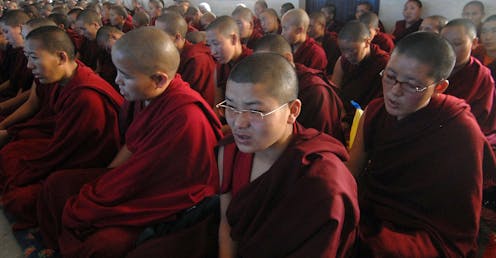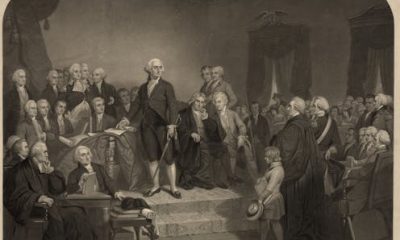
Tibetan Buddhist nuns offering prayers in Kathmandu. Prakash/Mathema /AFP via Getty Images
Images of Buddha’s enlightenment often portray him sitting alone under the bodhi tree, his body emaciated from fasting. Some depictions show the Buddha’s right hand pointing down, asking the earth goddess to bear witness to his enlightenment.
Demonic armies or dangerous temptresses can be shown on both sides of the Buddha, demonstrating his fortitude in the face of violent threats and seduction. In some images, he may also be flanked by two male disciples while expounding his teachings.
A third- to fifth-century statue of a fasting Buddha from the Kushan period.
Samuel Eilenberg Collection, Ex Coll.: Columbia University, Purchase, Rogers, Dodge, Harris Brisbane Dick and Fletcher Funds, Joseph Pulitzer Bequest, and Lila Acheson Wallace Gift, 1987
What is missing, however, from these images are Buddhist women. What does enlightenment look like for them?
I’m a scholar of women and gender in Buddhism, and one of the key questions driving my research is the unique ways in which enlightenment is experienced in a female body. This led me to the Therigatha, a collection of poems written in the Pāli language by female disciples of the Buddha.
Part of the Theravada Buddhist canon,
this collection reveals an intimate picture of enlightenment that is deeply embodied, does not necessarily require the renunciation of domestic life and is supported by a community of sisterhood.
Embodied enlightenment
The term “theri” means “female elders,” while “gatha” refers to the genre of songs or verses. These poems, compiled not long after the Buddha’s passing, are the oldest evidence of women’s religious experiences in Buddhism. Many of these female authors were disciples of the Buddha.
Their writings reveal a version of enlightenment that is not occupied by the usual image of a solitary meditating monk. Instead of seeking liberation from life and death through monastic discipline or meditation, enlightenment is experienced in the mind as well as in the body. It is found not just in remote hermitages but also in domestic spaces.
Moreover, the path to liberation for women is usually communal. Nuns learn from and with each other, as they become free from the human condition of suffering, one of Buddhism’s Four Noble Truths.
Consider the following verses from the Therigatha. The nun Uttama says:
For seven days I sat in one position, legs crossed,
Given over to joy and happiness.
On the eighth day I stretched out my feet,
After splitting open the mass of mental darkness.
Uttama may have meditated just like the Buddha, but in the end, she stretched out her feet – a movement of ease and freedom and a gesture of release from the hardship she endured.
Contrary to other Buddhist teachings that view the body as an undesirable container punctured by several openings that constantly leaked foul and revolting substances, here in the Therigatha, the body is present, even prominent, in the enlightened experience of Uttama.
In the Therigatha, the Buddha instructs the nuns repeatedly to take care of the body. Instead of letting it become a vehicle for death, they should cherish the human body they possess and make it a vehicle for liberation.
Another poem by Ambapali, a royal courtesan turned Buddhist nun, expresses a similar sentiment. Ambapali observes the changes in her body in detail: She remarks how her once glossy, black hair that was perfumed with flowers is now like jute; her eyes, once brilliant like jewels, have lost their luster; her neck, hands, arms, thighs and feet, which were all once beautiful, also bear witness to old age and impermanence.
Instead of being disgusted by these changes, her reflection focuses on the teaching of impermanence: “It’s just as the Buddha, the speaker of truth, said, nothing different than that.”
Here, the body is not viewed as only the enemy but a vehicle necessary for human liberation.
Finding liberation at home
The setting of poems in the Therigatha also frequently highlights domestic spaces women occupy. In one, Punna, a servant girl of low caste, taught a high-caste Brahmin a lesson on karma. While doing her morning chores of fetching water, she saw a priest performing his bathing purification ritual in ice-cold water. She questioned the efficacy of this ritual, and told him that liberation comes from the Buddha’s teaching, not by tormenting one’s body.
In another, Patachara, who was once the wife of a wealthy man but turned to renunciation after the untimely death of her children, relates the following:
First I looked at the bed, then I sat on the couch
I used a needle to pull out the lamp’s wick.
Just as the lamp went out, my mind was free.
While the nuns followed a monastic path of abandoning domestic life, it was the bondage of servitude, not the daily experience of living, that they left behind. For Patachara, there was no need for a bodhi tree; her mind was set free from suffering and entered enlightenment right in her hut after the mundane act of putting out her lamp.
Becoming enlightened, together
Nuns learned from not only the Buddha but from other nuns as well. They were encouraged to care for and support each other. In fact, the phrase “she seemed like someone I could trust” shows up multiple times in the Therigatha, when the nuns recalled how they started on the path in the first place.
A nameless nun writes:
With no peace in my heart, dripping with sexual desire,
I entered the monastery, wailing, my arms outstretched.
I approached the nun,
She seemed like someone I could trust.
She taught me the dhamma
About what makes a person
About the senses and their objects
And about the basic elements that make up everything.
The community of fellow practitioners in Buddhism is called the sangha. It is one of the Three Jewels, the other two being the teacher, the Buddha, and his teaching, the “dhamma.” Anyone who wishes to become a Buddhist will vow to take refuge in the Three Jewels, which support Buddhist practice. These are the teacher, the teaching and the community. In the case of this nameless nun – and many others – the Buddhist path is paved not only by the Buddha and his teachings but also by a community of trust and shared aspiration.
The poems in the Therigatha are a reminder that enlightenment does not always have to be a long trek in the woods but can happen right within one’s humble abode. For some, it could simply mean the joy of finding community.
Jue Liang does not work for, consult, own shares in or receive funding from any company or organization that would benefit from this article, and has disclosed no relevant affiliations beyond their academic appointment.
Advertisement

Advertisement
Contact Us
If you would like to place dofollow backlinks in our website or paid content reach out to info@qhubonews.com











